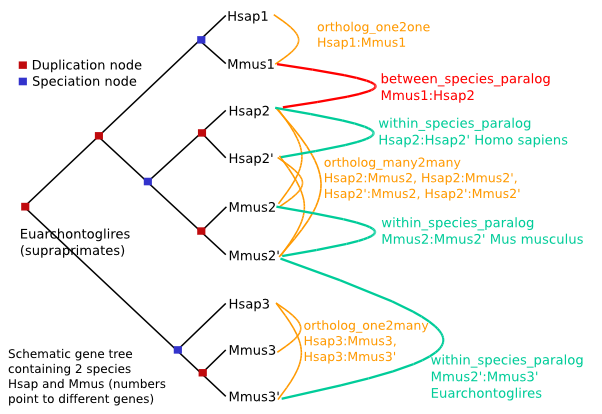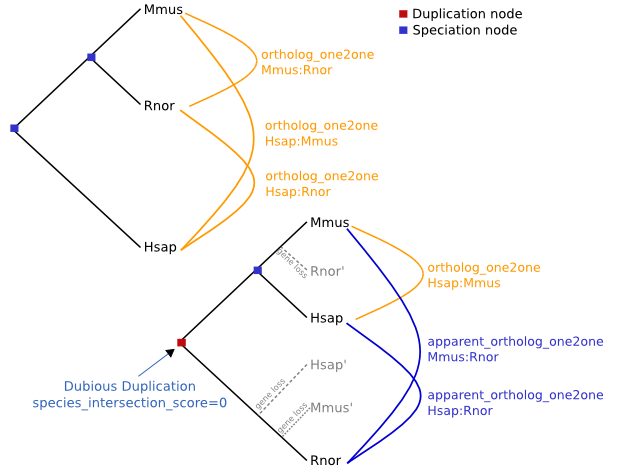Gene Orthology/Paralogy prediction method
The gene orthology and paralogy predictions are generated by a pipeline
where maximum likelihood phylogenetic gene trees (generated by TreeBeST)
play a central role. They aim to represent the evolutionary history of
gene families, i.e. genes that diverged from a common ancestor. These
gene trees reconciled with their species tree have their internal nodes
annotated to distinguish duplication or speciation events.
There is a clear concordance with reciprocal best approaches in the
simple case of unique orthologous genes. However, the gene tree
pipeline is able to find more complex one-to-many and many-to-many
relations. This, for instance, significantly raises the number of Teleost
(bony fish) to Mammal orthologs and has even more dramatic effects on
Fly/Mammal or Worm/Mammal orthologous gene predictions. Using this
approach, we are also able to "time" duplication events which produce
paralogs by
identifying the most recent common ancestor (=taxonomy level) for a
given
internal node of the tree.
The gene orthology and paralogy prediction pipeline has 7 basic steps:
1. Load the longest translation of each gene from all species used in
Ensembl
2. run WUBlastp+SmithWaterman of every gene against every other (both
self and non-self species) in a genome-wise manner
3. Build a graph of gene relations based on Best Reciprocal Hits
(BRH
1) and
Best Score Ratio (BSR)
2 values
4. Extract the connected components (=single linkage clusters), each
cluster
representing a gene family.
5. For each cluster, build a multiple alignment based on the
protein sequences using MUSCLE
3
6. For each aligned cluster, build a phylogenetic tree using
TreeBeST
4 using the CDS back-translation of the protein multiple alignment
from the original DNA sequences
**. A rooted tree with internal duplication tags is
obtained at this stage, reconciling it with the species tree in
'ensembl-compara/scripts/pipeline/species_tree_njtree.taxon_id.nh'.
7. From each gene tree, infer gene pairwise relations of orthology
* and
paralogy types.
* There is an extra optional step which calculates the dN/dS values for the
orthology relationships of closely related pairs of species. We use codeml in the
PAML
5 package (model=0, NSsites=0) for this.
We only calculate these dN/dS values for closely-related pairs of
species. When the species evolutionary distance is too large, the
saturation of the dS values biases the estimated dN/dS
ratio. For each pair of species we calculate a threshold on dS
which is 2 * median(dS). When the dS of a given ortholog gene pair is larger than
this threshold, we mask out the dN/dS ratio.
** A description of the tree building method in TreeBeST: the CDS
back-translated protein alignment (i.e., codon alignment) is used to
build 5 different trees:
(i) a maximum likelihood (ML) tree built using phyml, based on the protein alignment with the WAG model;
(ii) a ML tree built using phyml, based on the codon alignment with the Hasegawa-Kishino-Yano (HKY) model;
(iii) a neighbour-joining (NJ) tree using p-distance, based on the codon alignment;
(iv) a NJ tree using dN distance, based on the codon alignment; and
(v) a NJ tree using dS distance, based on the codon alignment.
For (i) and (ii), TreeBeST uses a modified version of phyml release
2.4.5 (Heng Li, unpublished) which takes an input species tree, and
tries to build a gene tree that is consistent with the topology of the
species tree. This "species-guided" phyml uses the original phyml
tree-search code. However, the objective function maximised during the
tree-search is multiplied by an extra likelihood factor not found in
the original phyml. This extra likelihood factor reflects the number
of duplications and losses inferred in a gene tree, given the topology
of the species tree. The species-guided phyml allows the gene tree to
have a topology that is inconsistent with the species tree if the
alignment strongly supports this. The species tree is based on the
NCBI taxonomy tree (subject to some modifications depending on new
datasets).
The final tree is made by merging the five trees into one consensus
tree using the "tree merging" algorithm. This allows TreeBeST to
take advantage of the fact that DNA-based trees often are more
accurate for closely related parts of trees and protein-based trees
for distant relationships, and that a group of algorithms may
outperform others under certain scenarios. The algorithm
simultaneously merges the five input trees into a consensus tree. The
consensus topology contains clades found in any of the input trees,
where the clades chosen are those that minimize the number of
duplications and losses inferred, and have the highest bootstrap
support. Branch lengths are estimated for the final consensus tree
based on the DNA alignment, using phyml with the HKY model.
Homology types:
Orthologues : any gene pairwise relation where the ancestor node is a
speciation event.
We predict several descriptions of orthologues.
ortholog_one2one
ortholog_one2many
ortholog_many2many
apparent_ortholog_one2one (is a special case, see below)
Paralogues : any gene pairwise relation where the ancestor node is a
duplication event.
We predict several descriptions of paralogues.
within_species_paralog
between_species_paralog

A within_species_paralog corresponds to a relation between 2
genes of the SAME species where the ancestor node
has been labelled as a duplication node e.g. H2:H2', M2:M2' but does
not necessarily mean that the duplication event
has occurred in this species only. For example, M2':M3' are
also within_species_paralog but the duplication event has occurred
in the common ancestor between species H and species M. If H is human
and M Mouse, the taxonomy level "times" the duplication
event to the ancestor of "Euarchontoglires".
A between_species_paralog corresponds to a relation between 2
genes of DIFFERENT species where the ancestor node
has been labelled as a duplication node e.g. M1:H2 or M1:H3.
Special cases of between_species_paralog can be singled out where they
can be characterised as one2one relations. Such cases are then relabelled
apparent_ortholog_one2one. Apparent orthologs can be the results of real
duplication followed
by gene loss (as shown in the picture below), but can also be the results of a wrong gene tree topology
and wrong duplication node labelling.
 Notes and References
1
Notes and References
1 BRH: Best Reciprocal Hit. When a query gene translation has an
unambiguous 'best' hit to a target translation, and that particular
target translation has an unambiguous 'best' hit back to the starting
query translation. The discrimination function for 'best' is a simple
sort of blastp >score,
%identity,
>%positivity.
2 BSR: Blast Score Ratio. When 2 proteins P1 and P2 are compared,
BSR=scoreP1P2/max(self-scoreP1 or self-scoreP2). This is, the score between
P1 and P2 (numerator) is compared to the score of P1 against itself and the score of P2
against itself (denominator). The default threshold used in the initial clustering step
is 0.33. This effectively relates the length of the P1 vs P2 match against the length
of P1 and P2 themselves, limiting the number of spurious short matches.
3 Edgar RC "MUSCLE: a multiple sequence alignment method with reduced time and space complexity" BMC Bioinformatics 2004 Aug 19;5:113.
4 Li H et al. TreeBeST: http://treesoft.sourceforge.net/njtree.shtml. Manuscript in preparation.
5 Yang Z "PAML: a program package for phylogenetic analysis by maximum likelihood"
Comput Appl Biosci. 1997 Oct; 13(5):555-556.

